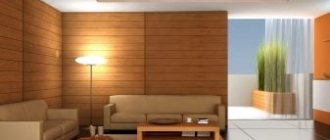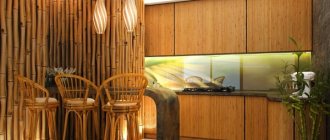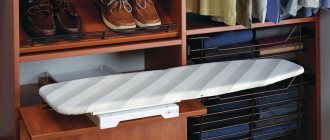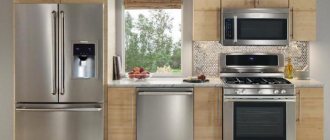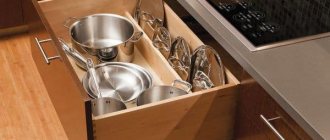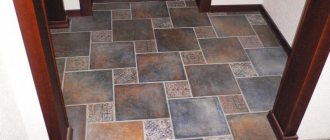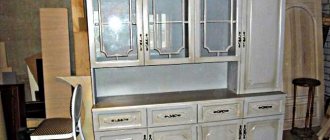To make the kitchen interior as beautiful as possible, you need to work hard. The kitchen space requires a special approach. When installing a pipeline, designers and residents are often faced with the question of how to properly hide the gas pipe in the kitchen. Utility networks laid on top of the wall can ruin the appearance of the room and completely ruin the entire interior. But if you want to hide an unsightly gas pipeline, it will be possible, although this must be done taking into account certain requirements.
Kitchen gas pipe, how to decorate it
Safety requirements when decorating a gas pipeline
Utility gas networks in most apartments are laid through the kitchen and are classified as dangerous installations. Representatives of regulatory services are not concerned about the beauty of the home’s interior; their demands are based solely on safety. Numerous tips on how to close a gas meter in the kitchen with photos are not always reliable. Therefore, you need to know the basic rules:
- one of the walls or door must be removable to provide quick access;
- it is necessary to provide a mesh or perforation for ventilation;
- the distance between the gas pipe and the wall of the box is from 5 cm.
When working with gas pipes, you must be extremely careful, since even the slightest crack can become the root cause of a serious accident.
For gas pipelines it is prohibited:
- hang different objects on them;
- insert into ventilation holes;
- lay tightly into the walls;
- arbitrarily cut off, transfer.
To protect the structure from rust and prolong its service life, it must be painted. For sealing it is necessary to use lightweight materials (wood, plastic). They must be resistant to moisture and household chemicals.
Construction of a plasterboard box to hide a gas pipe
If you are interested in how to cover a gas pipe in the kitchen, you will most likely hear advice - seal it with a plasterboard box. Indeed, plasterboard has a number of significant advantages: it has a relatively low price, is easy to install and use, the constructed box can be of any shape and size (for both vertical and horizontal pipes), and does not require special skills and tools for installation.
The construction of a plasterboard box in the kitchen is a good option for closing a gas pipe, it is not difficult - anyone can do it without outside help. Below is a detailed progress of the work.
Secure metal profiles. Based on them, the future frame will be formed. The main thing is to insert vertical crossbars between the profiles, creating additional stiffening ribs. Mark the necessary parts on the surface of the plasterboard sheet in accordance with the dimensions of the body, while adding a few millimeters to overlap one sheet with another at the corners. Fasten the cut-out parts from gypsum board to the profiles using self-tapping screws and a screwdriver. The main thing is to recess the heads into the surface of the box so that they do not stand out and spoil the finished decor. In addition to attaching sheets of plasterboard at the corners with an overlap, it is recommended to use joining tape at the joints, which gives the structure the effect of uniformity and integrity
After completing the installation work, you should proceed to the final stage of decoration, putty the surface of the box, paying special attention to the joints and recesses from the screw heads. Now the plasterboard box is no different from an ordinary wall
It is painted to match the color of the kitchen wall, laid out with tiles, and covered with wallpaper. A pipe closed in this way may include a gas meter and valve, access to which is required around the clock. Therefore, it is worth considering in advance the possibility of easy access - say, a small door or an inconspicuous removable panel.
The last point implies the main disadvantages of using a gypsum board box for decorating, which can cause problems with the gas inspection.
Firstly, direct non-compliance with safety requirements. Due to complete isolation, the emergency service will not be able to quickly get to the source of the gas leak in the kitchen, which can lead to big troubles. Secondly, the presence of a door or window maintains this complexity. The third problem is the excessive massiveness of the plasterboard box, which “eats up” the space of a small kitchen.
Is it possible to embed a pipeline into a wall?
Water supply and sewerage networks made of metal or plastic can be safely laid under plaster or behind plasterboard walls. Finished surfaces are designed in the same style as the interior. But at the same time, it is prohibited to remove meters and compartments with filters installed on them into the walls. As a rule, small doors are installed in such areas.
Gas pipes walled into the wall
As for gas pipes, everything is much more complicated here and this procedure will not work with them. The gas pipe in the kitchen is usually steel, so in places of contact with the cement mortar, in the presence of moisture, fistulas form over time, which lead to leakage.
If the newly purchased apartment has areas with a gas pipeline walled into the wall, then it is urgent to call specialists from the management company to redo this structure.
Tube decor in the kitchen and bathroom
If you need to hide and decorate communications in the kitchen, then this can be easily done with the help of a furniture set. This way, horizontal risers can be easily hidden behind a kitchen cabinet.
A vertical pipe can easily be veiled with a floor pencil case. With a small budget, you can safely use furniture that imitates the real thing. False structures will help you easily hide unsightly communications that do not fit into the overall design of the room.
You can disguise a gas pipe using parts of a furniture set. This method is the most optimal. You will not only hide the pipes, but also, if necessary, you will have free access to the column, fittings and meter.
You can also decorate any heating pipe in the bathroom quickly and easily. This can be done using the methods described above or any others. Before starting work, it is recommended to clarify information about what material the pipe is made of: stainless metal, plastic, etc. Most modern materials do not need painting. If the pipe is made of ferrous metal, then it must be cleaned of old material before painting.
There are many ways to decorate a pipe. After weighing all the pros and cons, you can find the best option for yourself. When choosing it, it is important that the overall stylistic idea in the room is maintained.
Any unsightly pipe can be turned into an original decorative element in the room. When decorating, do not forget that the heating or gas pipe must, first of all, fulfill its main functional task. If you are creative, the result will exceed all your expectations.
What are the methods for masking a gas pipe?
A favorite design technique is the use of ventilated decorative panels. It is recommended to use lightweight structures that are ventilated and can be easily dismantled. The most important condition is unhindered access to networks. There are many ways that do not violate the laws of operation.
Is it possible to hide a pipe in a plasterboard box?
It’s easy to assemble a simple structure with your own hands, using ordinary moisture-resistant, fire-resistant gypsum plasterboard and profiles, providing access to the route. The decorative box will be part of the wall, and the gas pipeline will be completely hidden behind it. An organized closed structure must have air ventilation; for this purpose, a mesh or special perforation is used. This eliminates gas formation in the event of a leak or emergency.
In addition to gypsum boards, frosted glass, perforated MDF, lining, polymer, and plastic are often used.
Disguise as a roof rail
Gas pipe hidden behind the railing.
Functional kitchen pipes serve as an additional cover in contrast. Kitchen railing systems are often used where the lines run in the opening between the cabinets and the countertop. They are usually placed parallel to the kitchen apron. The decorative rod is installed just below the pipe line. You can hang various utensils, spices, cups, and potholders on it. Thus, utility networks can become the core of the interior composition.
The gas main serves solely as a decoration; nothing can be hung or attached to it.
Laying pipes above furniture
To ensure that utility networks do not spoil the design or interfere with the arrangement of furniture, they can be moved to another location. But this cannot be done with every highway. If the turns and loops of the gas supply system do not suit the owner, he can request a relocation service based on current requirements from an authorized company.
When transferring or replacing gas utility networks, the work is carried out after the furniture has already been installed and it is not planned to change it in the near future.
The project must be developed and agreed with the management of the gas supply company, and the installation is carried out by professionals who block the main lines in the building and perform the installation. Typically, workers place the horizontal part of the pipeline directly above the cabinets, and with the help of inserts they lay vertical sections close to the high and narrow parts of the furniture.
Placing pipelines inside furniture
Vertical elements are usually hidden in a pencil case, and horizontal elements are placed in a cabinet. The advantage of this option is that there is constant access to all equipment, and if the kitchen area is limited, then the shelves are used for their intended purpose. Manufactured furniture products must have no back walls. For a column, the cabinet must be made open at the top; for this, the top element can simply be cut out. The doors are made of a lattice barrier, which is at the same time decorative, but at the same time not airtight.
Gas pipe behind the kitchen door
Hanging furniture elements for dishes with voids will cost more, since they will have to be made to order in the showroom.
Masking by dyeing
A universal painting method is to coat the pipes to match the walls with non-vapor-permeable paint, suitable for:
- acrylic;
- oil;
- nitro enamel.
Selecting a color scheme to match the color of the wall decoration will eliminate the formation of contrast and hide highways even in a small space of a Khrushchev panel building. Before painting, the old coating must be removed and the coating must be cleaned. Sometimes the pipe is painted to resemble a tree trunk, for example, a birch. Those who know how to draw well will be able to create unusual graphic, floral, ornate patterns. In high-tech or minimalist design, it is permissible to paint all pipe systems in a metallic tone.
Textile decor
Gas networks or a meter are easily hidden behind blinds, curtains, curtains when they are located near a window. For a complete combination, the surface of the highway is painted in a color identical to the color of the textile. This is the simplest and most rule-free method.
The smallest leak of household gas can be fatal. Gluing beautiful cords, magnets and other hand-made decors may cause criticism from inspection companies, since decorating elements should not complicate access and ventilation. In addition, using this method often only serves to draw attention to the pipeline rather than to play with it.
Decorating with bamboo panels
Pipes inside bamboo sticks
Pipe lines can be decorated with unique elements that can add zest to the entire kitchen. Securing bamboo sticks by cutting is a budget-friendly and beautiful way. The trunk must be large in diameter; it is cut along its entire length and attached to the communications with plastic ties or twine. This replaceable casing has an attractive natural texture and would be appropriate, for example, in an eco-style.
Using decoupage
The original technique allows you to transfer a design from a napkin or a special film to the surface of a gas pipeline. In this case, there remains free access to utility networks for maintenance and preventive inspections. Furniture, curtains, interior decoration, kitchen appliances must be coordinated in a carefully thought-out style and consistent with the idea.
Box made of PVC panels
In this simple way, you can hide not only the pipes, but also the chimney, and the equipment included in the system - the meter and the boiler. Installation of a plastic box is carried out in the same way as from gypsum plasterboard. Its joints and external corners are covered with decorative corners. For owners of a gas heating unit, the question of how to hide a gas hose in the kitchen is especially relevant? This problem is effectively solved by PVC panels and boxes.
The installation must be carried out so that there is enough free space inside the box for access to the components of the line.
Pipe - part of the interior
Use of decorative textiles
This decor option will allow communications to fit more organically into the interior. There may also be a lot of options here. The most popular materials are twine, tent cord, and rope.
Decorative rope should be tightly wrapped around the pipes. To secure the rope while threading its ends, you must use glue. You can add decorative elements. For example glass beads, shells or artificial leaves and flowers.
Decoration using decorative twine.
Bamboo
Decorative bamboo looks unconventional; moreover, it has a shape identical to the pipes, which makes it easy to install; you just need to select the bamboo of the desired diameter.
Decorating with bamboo.
Chrome bar counter
If the kitchen has a bar counter or rails, this element will fit well into the interior. You just need to choose the right diameter of the railing and pass the gas hose through it.
Instead of a bar counter, you can use a flexible hose and pass it between the cabinets and the countertop into the prepared hole.
Dependence of choice on various factors
When choosing one of the listed methods, you should weigh all the pros and cons and choose only the right one:
- budget - special sleeves (casings);
- pipes next to the sink - hide in wooden cabinets;
- in the middle of the wall - in a box, use decoration;
- in the corner is the easiest installation of the box, since you only need to cover two planes, and it’s even easier to put a refrigerator in this place.
- The height of the line is sometimes 70–80 cm from the floor and it can be successfully hidden in the lower cabinets, under the countertop.
A pipe disguised as a loft style
will complement the unsightly numerous communications painted with copper-bronze paint well and fit coherently into the loft style.
Decoration options
If desired, the owners can decorate a pipe or part of the equipment that cannot be hidden using traditional methods. The decoration method can be any, depending on the creativity, imagination and ingenuity of the owners.
An example of a good idea for camouflaging a heating pipe or gas pipeline is:
- applying stickers or drawings under wallpaper, tree bark, foliage or other images similar in color and theme;
- the use of mosaics and other decorative elements (artificial and natural stone, shells, pebbles).
The final option, when other camouflage options are not suitable, is to paint the pipe in the color of the wallpaper, wall or furniture. This will make it visually invisible and allow it to fit into the surrounding space.
The layout of each apartment is unique, which allows for the opportunity to experiment. The main thing is to comply with existing technical requirements and SNiP standards so that the decor does not cause an emergency.
other methods
Other ways to hide communications are to use a horizontal pipe as a rail for kitchen utensils (ladles, spoons, potholders, aprons), as well as disguise them using floor or ceiling plinths (provided that the pipes are relatively thin).
You should not hang heavy pans or pots on a horizontal pipe to avoid deformation, especially if we are talking about a gas pipe; this is not only fraught with punishment in the form of fines from gas services, but also life-threatening.
Prohibited techniques for masking a pipe
It is necessary in time, even at the stage of drawing up the project, before carrying out repairs, taking into account the arrangement of furniture, to worry about hiding the pipelines. Simple, easy solutions to problems often turn out to be wrong.
It is strictly prohibited:
- lay communications, especially gas ones in ventilation ducts, under the floor, behind the suspended ceiling;
- build the speaker into furniture and intersect with other communications;
- swap or combine the air duct of a gas boiler (boiler) and a kitchen hood;
- connect the slabs to the gas pipeline using a thin elastic hose, which is easily hidden in the hole.
It is better not to hide the gas pipeline, but to make it an original part of the interior. Although this approach will require good design taste from the performer, in order to comply with safety laws, the solution is ideal.
How to hide a gas meter in the kitchen
It is not forbidden to hide flow meters behind a box, false wall, in a closet or drawer. In these cases, access must also be organized for monitoring and emergency services. For example, if a shelf is located close to the device, then it is better not to store anything on it so as not to block access to the measuring device. The most common option is to hide the counter in a cabinet next to the kitchen unit or in a separately ordered pencil case that will match the unit in color and style. You can make a unique removable door from unusual glass or magnets.
How to close (hide) a pipe?
Plasterboard box or cabinet
Drywall is an easy to install and inexpensive material. It's perfect for hiding pipes in any room. To do this you will need to make a box.
We will need sheets of drywall, galvanized metal profiles, self-tapping screws, as well as putty and paint.
You need to make a frame from metal profiles. It must be fixed in 3 places - at the junction of sheets, on the floor and on the walls. This allows us to ensure the necessary rigidity of the structure. Previously prepared pieces of drywall are attached to the mounted frame. Then, the box must be puttied and painted. Or subject it to a different finish. For example, you can cover the box with wallpaper or lay tiles on it. It all depends on the kitchen design and your imagination.
Using the same principle, you can create a structure from chipboard, plywood or plastic.
Plasterboard box. Tile decoration.
To access communications (gas valve and meter), you can make a box with a door.
White plastic box.
Kitchen module
If the placement of the headset allows, then you can maintain the ideal interior. Using wall cabinets that do not have back walls. Vertical pipes can be hidden behind cabinets , and horizontal pipes can be placed along the shelves of kitchen cabinets. It is better to use blind doors or lattice facades. The pipe will be visible through the wall door.
Using the same principle, you can use a solid high cabinet .
Gas meter and pipe in the far right cabinet (column) - large photo
It is advisable to cover the pipe that needs to be hidden with a plasterboard box. This will make it possible to putty the surface, prime it, and then paint it with any type of paint for interior work, paste it with wallpaper, cover it with plastic and other panels, decorate it with artificial stone, porcelain stoneware, decorative plaster, and so on, depending on the general covering of the walls, and room design.
How to hide a gas cylinder in the kitchen
An interesting solution for a gas cylinder in the kitchen.
In kitchen areas it is allowed to place a flammable gas cylinder with a capacity of no more than 12 liters. It will have to be constantly checked for leaks, gaskets changed, and refilled.
It is prohibited to place or hide gas cylinders in basements and cellars.
To hide an unsightly cylinder, a plasterboard structure or a large pencil case without a back wall is perfect. Transparent doors allow you to control fuel consumption.



